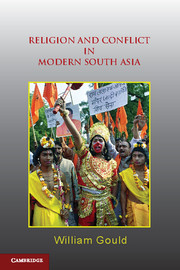Book contents
- Frontmatter
- Contents
- Abbreviations
- Glossary
- Acknowledgements
- 1 Introduction
- 2 Building Spheres of Community
- 3 Transforming Spheres of Community
- 4 Defining Spheres of Community
- 5 State Transformation, Democracy and Conflict
- 6 Forging National Consensus and Containing Pluralism
- 7 New Conflicts and Old Rivalries
- 8 The Resurgence of Communalism?
- Conclusion
- Bibliography
- Index
- References
1 - Introduction
Community and Conflict in South Asia
Published online by Cambridge University Press: 05 June 2012
- Frontmatter
- Contents
- Abbreviations
- Glossary
- Acknowledgements
- 1 Introduction
- 2 Building Spheres of Community
- 3 Transforming Spheres of Community
- 4 Defining Spheres of Community
- 5 State Transformation, Democracy and Conflict
- 6 Forging National Consensus and Containing Pluralism
- 7 New Conflicts and Old Rivalries
- 8 The Resurgence of Communalism?
- Conclusion
- Bibliography
- Index
- References
Summary
In the aftermath of one of the most dramatic British colonial retreats – that of the summer of 1947 – two entirely separate states were created out of British India – one on the extraordinary basis of religious community and the other on its denial. Each was founded upon apparently contrary ideas about what constituted a ‘nation’. On the one side lay the outwardly secular democratic state of India. The leading political movement of late colonial India – the Indian National Congress – representing itself as the only truly ‘national’ organisation in the region, had to claim to represent all Indians. On the surface at least, it eschewed the politics of religious community from its very beginning in 1885, as a colonial tactic to divide and rule Indian society. From the very beginning too, though, the Congress’s commitment to secularism became more vague and inapplicable the closer it came to local politics. This could be seen in the 1880s and 1890s when the interests of urbane Congress publicists from the great cities of Bombay, Calcutta and Madras came into conflict with the radical Hindu mobilisers of western and northern India. It could also be seen in the late 1940s, when the secular modernist Jawaharlal Nehru struggled for control of the Congress with the UP leader, Purushottam Das Tandon. The former shunned the self-proclaimed champions of the ‘Hindu community’ as reactionaries. The latter, while taking a leading role in the Congress, actively organised the Hind Raksh Dal (Protection of India Party) around the principles of Hindu mobilisation, which involved militaristic protection of the ‘homeland’ from anti-national (Muslim) elements. Independent India was a secular state, but it was clearly a fragile and contested secularism.
On the other side lay the new state of Pakistan, divided by thousands of miles between the western part of Punjab and the eastern half of Bengal, and founded on the principle that the Muslim community of India represented a separate nation. For its champion, Mohammad Ali Jinnah, the ‘two-nation theory’, as it came to be known from the early 1940s, did not necessarily imply a push for an entirely separate sovereign state, cut off completely from the rest of India. Yet the clear principles underlying the Muslim League were that the Muslims of India should be seen as a separate political-interest group, with separate rights that could only be represented by co-religionists. This contradicted a powerful tradition in radical Muslim leadership in India, which had, since the first decade of the twentieth century, often worked within or alongside the Congress (a tradition that included Jinnah himself). It also made no sense to large swathes of the Indian Muslim population, who lived comfortably side by side with their co-religionists, took part in Hindu festivals or who worshipped according to regional devotional practices. And when Pakistan was finally formed, not only did a greater number of Muslims remain in India than migrated to the new state, but many who had migrated returned to India in the years following the violence of partition.
- Type
- Chapter
- Information
- Religion and Conflict in Modern South Asia , pp. 1 - 29Publisher: Cambridge University PressPrint publication year: 2011
References
- 1
- Cited by



